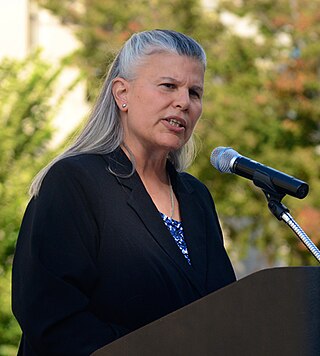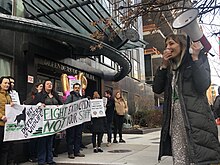
The United States Fish and Wildlife Service is a U.S. federal government agency within the U.S. Department of the Interior which oversees the management of fish, wildlife, and natural habitats in the United States. The mission of the agency is "working with others to conserve, protect, and enhance fish, wildlife, plants and their habitats for the continuing benefit of the American people."

The Endangered Species Act of 1973 is the primary law in the United States for protecting and conserving imperiled species. Designed to protect critically imperiled species from extinction as a "consequence of economic growth and development untempered by adequate concern and conservation", the ESA was signed into law by President Richard Nixon on December 28, 1973. The Supreme Court of the United States described it as "the most comprehensive legislation for the preservation of endangered species enacted by any nation". The purposes of the ESA are two-fold: to prevent extinction and to recover species to the point where the law's protections are not needed. It therefore "protect[s] species and the ecosystems upon which they depend" through different mechanisms. For example, section 4 requires the agencies overseeing the Act to designate imperiled species as threatened or endangered. Section 9 prohibits unlawful ‘take,’ of such species, which means to "harass, harm, hunt..." Section 7 directs federal agencies to use their authorities to help conserve listed species. The Act also serves as the enacting legislation to carry out the provisions outlined in The Convention on International Trade in Endangered Species of Wild Fauna and Flora (CITES). The Supreme Court found that "the plain intent of Congress in enacting" the ESA "was to halt and reverse the trend toward species extinction, whatever the cost." The Act is administered by two federal agencies, the United States Fish and Wildlife Service (FWS) and the National Marine Fisheries Service (NMFS). FWS and NMFS have been delegated by the Act with the authority to promulgate any rules and guidelines within the Code of Federal Regulations (CFR) to implement its provisions.

The National Wildlife Federation (NWF) is the United States' largest private, nonprofit conservation education and advocacy organization, with over six million members and supporters, and 51 state and territorial affiliated organizations (including Puerto Rico and the Virgin Islands).

Wildlife conservation refers to the practice of protecting wild species and their habitats in order to maintain healthy wildlife species or populations and to restore, protect or enhance natural ecosystems. Major threats to wildlife include habitat destruction, degradation, fragmentation, overexploitation, poaching, pollution, climate change, and the illegal wildlife trade. The IUCN estimates that 42,100 species of the ones assessed are at risk for extinction. Expanding to all existing species, a 2019 UN report on biodiversity put this estimate even higher at a million species. It is also being acknowledged that an increasing number of ecosystems on Earth containing endangered species are disappearing. To address these issues, there have been both national and international governmental efforts to preserve Earth's wildlife. Prominent conservation agreements include the 1973 Convention on International Trade in Endangered Species of Wild Fauna and Flora (CITES) and the 1992 Convention on Biological Diversity (CBD). There are also numerous nongovernmental organizations (NGO's) dedicated to conservation such as the Nature Conservancy, World Wildlife Fund, the Wild Animal Health Fund and Conservation International.

The Canadian Wildlife Service or CWS, is a Branch of the Department of Environment and Climate Change Canada, a department of the Government of Canada. November 1, 2012 marked the 65th anniversary of the founding of Service.

The conservation status of a group of organisms indicates whether the group still exists and how likely the group is to become extinct in the near future. Many factors are taken into account when assessing conservation status: not simply the number of individuals remaining, but the overall increase or decrease in the population over time, breeding success rates, and known threats. Various systems of conservation status are in use at international, multi-country, national and local levels, as well as for consumer use such as sustainable seafood advisory lists and certification. The two international systems are by the International Union for Conservation of Nature (IUCN) and The Convention on International Trade in Endangered Species of Wild Fauna and Flora (CITES).

The Wildlife Trust of India is an Indian nature conservation organisation.

The Center for Biological Diversity is a nonprofit membership organization known for its work protecting endangered species through legal action, scientific petitions, creative media and grassroots activism. It was founded in 1989 by Kieran Suckling, Peter Galvin, Todd Schulke and Robin Silver. The center is based in Tucson, Arizona, with its headquarters in the historic Owls club building, and has offices and staff in New Mexico, Nevada, California, Oregon, Illinois, Minnesota, Alaska, Vermont, Florida and Washington, D.C.

A species of special concern is a protective legal designation assigned by the California Department of Fish and Wildlife (CDFW) to wildlife species that are at risk.

An endangered species is a species that is very likely to become extinct in the near future, either worldwide or in a particular political jurisdiction. Endangered species may be at risk due to factors such as habitat loss, poaching, and invasive species. The International Union for Conservation of Nature (IUCN) Red List lists the global conservation status of many species, and various other agencies assess the status of species within particular areas. Many nations have laws that protect conservation-reliant species which, for example, forbid hunting, restrict land development, or create protected areas. Some endangered species are the target of extensive conservation efforts such as captive breeding and habitat restoration.

Manatees are large marine mammals that inhabit slow rivers, canals, saltwater bays, estuaries, and coastal areas. They are a migratory species, inhabiting the Florida waters during the winter and moving as far north as Virginia and into the Chesapeake Bay, sometimes seen as far north as Baltimore, Maryland and as far west as Texas in the warmer summer months. Manatees are calm herbivores that spend most of their time eating, sleeping, and traveling. They have a lifespan of about 60 years with no known natural enemies. Some of their deaths are the result of human activity. In the past, manatees were exploited for their meat, fat, and hides.

Conservation-reliant species are animal or plant species that require continuing species-specific wildlife management intervention such as predator control, habitat management and parasite control to survive, even when a self-sustainable recovery in population is achieved.

The United States Fish and Wildlife Service Office of Law Enforcement contributes to Service efforts to manage ecosystems, save endangered species, conserve migratory birds, preserve wildlife habitat, restore fisheries, combat invasive species, and promote international wildlife conservation. It is an office of the United States Fish and Wildlife Service (FWS).
The Wildlife Conservation Network (WCN) is a United States-based 501(c)(3) non-profit organization that protects endangered wildlife by supporting conservationists in the field who promote coexistence between wildlife and people. WCN does this by providing its partners with capital, strategic capacity-building services, training, and operational support. WCN has been given a top rating amongst wildlife conservation charities, with a four star rating on Charity Navigator.

A Habitat Conservation Plan (HCP) is a required part of an application for an Incidental Take Permit, a permit issued under the United States Endangered Species Act (ESA) to private entities undertaking projects that might result in the destruction of an endangered or threatened species. It is a planning document that ensures that the anticipated take of a listed species will be minimized or mitigated by conserving the habitat upon which the species depend, thereby contributing to the recovery of the species as a whole.

Sierra Club v. Babbitt, 15 F. Supp. 2d 1274, is a United States District Court for the Southern District of Alabama case in which the Sierra Club and several other environmental organizations and private citizens challenged the United States Fish and Wildlife Service (FWS). Plaintiffs filed action seeking declaratory injunctive relief regarding two incidental take permits (ITPs) issued by the FWS for the construction of two isolated high-density housing complexes in habitat of the endangered Alabama beach mouse. The District Court ruled that the FWS must reconsider its decision to allow high-density development on the Alabama coastline that might harm the endangered Alabama beach mouse. The District Court found that the FWS violated both the Endangered Species Act (ESA) and the National Environmental Policy Act (NEPA) by permitting construction on the dwindling beach mouse habitat.
An out-of-danger species is an animal or plant species formerly categorized as Rare, Vulnerable, or Endangered that has since been removed from these lists because the species' survival has been relatively secured, e.g. Ginkgo biloba. Often known as a delisted species, these animals have been moved out of the Rare, Vulnerable, or Endangered categories through conservation efforts and government policymaking to ensure their survival and population growth. The International Union for Conservation of Nature (IUCN) established its list of endangered species in 1964, subsequently becoming a global authority on wildlife conservation. The following year, the United States created the U.S. Fish and Wildlife Service to act as a federal authority on endangered species. Currently, both international and domestic organizations implement recovery efforts and track species' population growth, delisting when necessary. Removing a species from the endangered species list is generally a slow process; most organizations and governments require long periods of observation both before and after delisting. There have been numerous efforts to delist endangered species, with both international and country-wide recovery plans being regularly implemented. These programs have led to the recovery of dozens of species, but their overall effectiveness remains contested.

Jamie Rappaport Clark is an American conservationist and former government official working as the president and CEO of Defenders of Wildlife. She joined the organization as executive vice president in 2004.

Conservation banking is an environmental market-based method designed to offset adverse effects, generally, to species of concern, are threatened, or endangered and protected under the United States Endangered Species Act (ESA) through the creation of conservation banks. Conservation banking can be viewed as a method of mitigation that allows permitting agencies to target various natural resources typically of value or concern, and it is generally contemplated as a protection technique to be implemented before the valued resource or species will need to be mitigated. The ESA prohibits the "taking" of fish and wildlife species which are officially listed as endangered or threatened in their populations. However, under section 7(a)(2) for Federal Agencies, and under section 10(a) for private parties, a take may be permissible for unavoidable impacts if there are conservation mitigation measures for the affected species or habitat. Purchasing “credits” through a conservation bank is one such mitigation measure to remedy the loss.

















